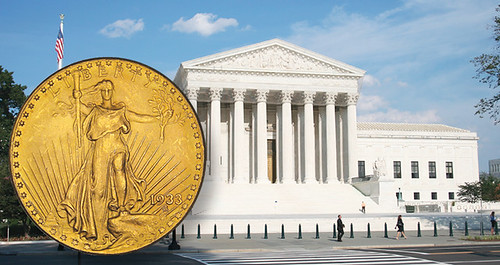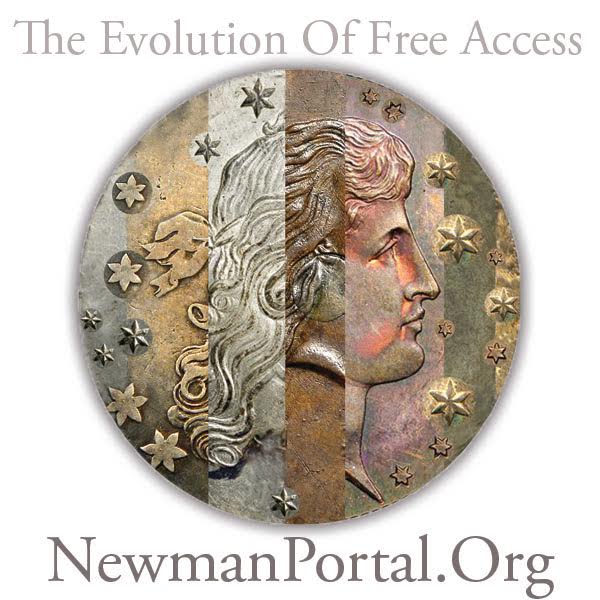
PREV ARTICLE
NEXT ARTICLE
FULL ISSUE
PREV FULL ISSUE
1933 DOUBLE EAGLE CASE MAY GO TO SUPREME COURTOne coin Josiah Lilly didn't have was the 1933 $20 gold piece, which had been declared by the government as illegal to hold. The only publicly known piece at that time was the Farouk specimen, which had been withdrawn from the sale of the Palace Collection and gone into hiding. But a secret hoard was in the hands of Israel "Izzy" Switt, a Philadelphia dealer with contacts at the U.S. Mint. Descendants of Switt, the Langbord family, filed a petition with the U.S. Supreme Court this week in what could lead to the ultimate resolution to the battle over their ten 1933 double eagles. Here's an excerpt from a November 11, 2016 Coin World story by Steve Roach. -Editor

The Langbord family filed a petition with the United States Supreme Court on Nov. 4, asking the nation’s highest court to overturn a District and Appellate court who each held that the family’s 10 1933 Saint-Gaudens double eagles were stolen government property. The filing repeatedly warns that the issues at hand are bigger than the 10 coins that were allegedly found by Joan Langbord in her family’s safe deposit box in 2003 and directs the Supreme Court to two key questions. First, the petition asks whether the government can avoid the rules set forth in the Civil Asset Forfeiture Reform Act of 2000 (CAFRA) when it seizes property from private citizens and intends to keep it by asserting that it was stolen government property and declaring that it has no intention of seeking forfeiture. The second question is whether the government can avoid CAFRA’s protections by waiting for years and then filing a declaratory judgment claim that seeks the same relief. In asking these two questions, the filing states that the court would give clear guidance to the government, property owners and lower courts in determining when CAFRA’s timelines and protections are triggered. Assessing a broader interest beyond a specific pattern is crucial in making a persuasive request to the Supreme Court, who only hears a small fraction of the cases presented to it. Parties who disagree with a lower court’s decision are allowed to petition the Supreme Court to review a case. The petition for a writ of certiorari was submitted on behalf of Joan Langbord and her sons, Roy and David, by the family’s longtime attorneys Barry Berke and Eric Tirschwell. At the core of the petition is CAFRA, which Congress passed in 2000 to provide added protections to individuals by shifting the burden of proof to the government to prove when property can be subject to forfeiture. CAFRA established procedures, deadlines and penalties to ensure that disputes over seized property were fairly and promptly resolved through legal channels. The filing warns that as it was applied in the Langbord case, “the purposes and principles of this groundbreaking law are thus turned upside down, granting the government virtually unfettered powers to delay, harass and burden the rare citizens who attempt to fight back against government overreaching.” Joan Langbord allegedly found the disputed coins in 2003 when looking through property that had belonged to her father, Israel “Izzy” Switt.
I couldn't tell a writ of certiorari from an eye of newt. This is why the hobby needs a strong subscription publication like Coin World - only a paid staff of professionals can hope to properly cover a complicated years-long story like this. People tend to think of The E-Sylum as a scholarly publication because it looks and feels like one, but the truth of the matter is that internet blogs like this are built on smoke and mirrors. It's just me, one person working part time to throw something together with no staff, fact-checkers or editors to ensure accuracy. I'm lucky because the quality of our readership and contributors is so high - that's the secret sauce. I couldn't begin to write an authoritative article on this topic, even though I've read both books and followed the story for years. I'm a Coin World subscriber, and most of you should be, too. -Editor
To read the complete article, see:
There was a lot of discussion about this on the PCGS US Coin Forum this week. Thanks to Len Augsburger for forwarding the link. A poster believed to be Roy Langbord supplied a link to a copy of the document filed with the supreme Court.
-Editor
To read the complete article, see:
To read the Langbord Petition for Writ of Certiorari, see:
I asked Harvey Stack about conversations the Stacks may have had with Josiah Lilly about the 1933 double eagle.
Harvey writes: Remember that the one Farouk had was sent to him with a license from the Secretary of the Treasury in 1944 as he was a important ally to the U.S. That is the coin that ws later seized and sold for over $7 Million. During the 1940's the Secret Service, under the direction of Leland Howard, who in 1961 became Director of Gold and Silver Operations for the Treasury had the Secret Service try to seize any 1933 on the market. One was removed from our Wharton sale in 1947, and people like Eliasberg and James Stack to mention a few surrendered their examples for they were being seized, and did not want the Treasury to try to grab theirs, and also make some sort of ruling that the other Gold coins in their collection were "collectibles" according to the Gold Acts pf 1933 and 1934. They felt that if the coin was made a collectible again, they would buy one once again for their collections. There was a trial in 1947 and Wharton rather than continue his fight, surrendered his coin to the Secret Service. He was initially represented by Harry J.Stein, a numismatist, who was the lawyer who attempted to force the return of the coin in 1947-8 when the appeal lost again. So since we could not sell the coin legally, we never sought one, nor did Lilly want one. Had he been alive in 2002 when we sold the only legal one to own today along with Sothebys I am sure we would have had a super bid from him. 
Wayne Homren, Editor The Numismatic Bibliomania Society is a non-profit organization promoting numismatic literature. See our web site at coinbooks.org. To submit items for publication in The E-Sylum, write to the Editor at this address: whomren@gmail.com To subscribe go to: https://my.binhost.com/lists/listinfo/esylum All Rights Reserved. NBS Home Page Contact the NBS webmaster 
|